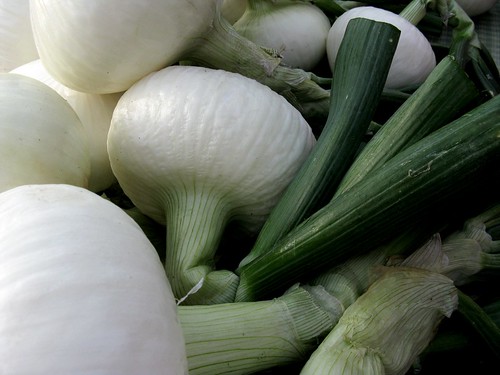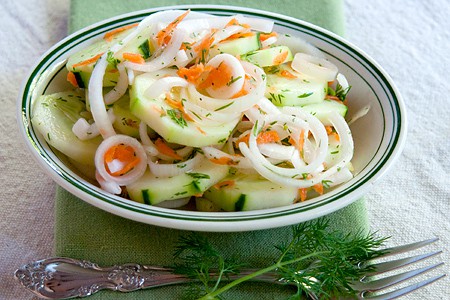Cropedia:Sweet Onion
Sweet Onion

Source: [1]
Years grown at UBC Farm/LFSOG: 5
Growing conditions
Most onion varieties begin bulb formation when the temperature and hours of daylight reach certain levels. Onions can belong to the "Long Day Bulbs", which begin to form a bulb when there is 14-16 hours of daylight, or "Short Day Bulbs", which begin to bulb when there is 12 - 14 hours of daylight hours. Sweet onion belongs to long-day bulb and grow better in the Northern latitudes. When growing sweet onion, provide it with 12 to 14 hours of sunlight.
Onion seeds, transplant and sets (small onion bulbs) are three ways to grow sweet onion. Among the three choices, seeds take the longest time while planting sets are the easiest way to grow bulb onions. Plant seeds with a uniform distanced apart,around 3 to 4 inches in double rows six to ten inches apart. This helps produce an even-sized crop with higher yield and can get fewer culls. Raising early transplants or direct sow can also increase the yield. Plant transplants 1 inch deep. Space transplants about 4 inches apart. Rows are still about 15 inches apart. Plant sets about 1 ½ to 2 inches deep in 15 inch rows (West Coast Seeds, 2010).
Sweet onions are shallow-rooted and grow best in soft, neutral and organic-material-rich soil. Constant supply of moisture is crucial to the soil. Keeping the soil moist also allows good drainage. Weeds and grass compete with the onion plants for nutrients and moisture during the growing season. Keep sweet onions free from them by removing the weeds and grass, and keep repeating shallow cultivation and hoeing. Side-dressing with fertilizer may or may not be necessary, depending on the growing condition (Ministry of Agriculture and Lands, 2010).
Sweet onions usually mature in 110 to 125 days for seed, 70 to 90 days for transplant and 50 to 60 days for bulbs. Mature sweet onions can get up to 13cm (5 inches) across. When they reach their mature size, they should be harvested. As sweet onions are high in water and sugar content, they spoil more rapidly than any other onions and thus require more care when storing. They have to be kept in a dry, cool and dark place with plenty of air circulation (Bellinon, 2008).
Sweet onions should be resistant to insect and disease problems. However, in order to prevent these concerns, it is recommended to rotate the location of the onion crop every year.
Seasonality
Sweet onion is spring/summer fresh onion. Seeds (open pollinated) are planted in mid-April. Sweet onions are available throughout their season, that is, from March to August. Because their individual seasons are short, they often command premium prices (West Coast Seeds, 2010).
Nutritional Information
Sweet onions are just like any other onions in nutritional basis. They contain vitamin A and C, phosphorous and potassium. The table below shows more detailed nutrition facts.
However, it is being suggested that fresh onion juice has antibacterial property. This is due to the action of allicin-type compounds. When allicins and disulfides interact with thiol (-SH) compunds, such as cysteine, a complex will incorporate into proteins and inhibit the growth of bacteria. Onion extract also carries hypoglycemic action. It is capable of preventing insulin reduction and thus causes blood sugar-lowering effect. Moreover, onions extract are reported to have lipid-lowering effects. Onion juice is shown to prevent the rise of serum cholesterol and prevent the accumulation of lipid in the aorta in rabbits fed with a high cholesterol diet. The mechanism of action was attributed to the properties of sulfur compounds in the active fractions. Moreover, onions have antioxidant activity.
We should look for sweet onions that are light golden-brown in colour, with a shiny tissue-thin skin and firm, tight, dry necks. When cut into, sweet onions should have a creamy white interior. Avoid onions that have soft spots or surface bruises.
When cutting sweet onion, it is recommended to peel and slice them beginning at the pointy end opposite the root. Also, there are few tricks to minimize the tear shedding effect when cutting an onion. They include refrigerating the onion or running cold water over them before slicing. It is because cold temperature can slow down the chemical reaction rate that begin when the onion is cut. Using a sharp knife is another trick. A sharp knife avoid additional cells near the cut from being crushed. So, the amount of irritating sulfur-compounds being released into the air can be reduced.
| Nutrition Facts/Valeur Nutritive | |
|---|---|
| Serving Size: 148g (1 Medium Size) | |
| Amount Per Serving | %Daily Value* |
| Calories 60 | |
| Total Fat 0g | 0% |
| Saturated Fat 0g | 0% |
| Trans Fat 0g | |
| Cholesterol 0mg | 0% |
| Sodium 5mg | 0% |
| Total Carbohydrate 14g | 5% |
| Dietary Fiber 3g | 12% |
| Sugars 9g | |
| Protein 2g | |
| Vitamine A | 0% |
| Vitamine C | 20% |
| Calcium | 4% |
| Iron | 2% |
| * % Daily value based on a 2000 calorie diet | |
Recipes
Cucumber And Sweet Vidalia Onion Salad

Due to the high sweetness in sweet onions, they are often used and salsa and sautés, as well as eaten raw in salads.
For this recipe, a tasty and traditional Cucumber and Sweet Vidalia Onion Salad, you won’t need fancy or unusual varieties of cucumbers. This recipe works great with cucumber varieties most home cooks are probably already familiar with: pickling cucumbers, as well as the long green “burpless” or English cucumbers. If not grown at home, these varieties are easily found at farmers’ markets across the nation.
Read more: http://www.lanascooking.com/2012/04/13/sweet-and-sour-cucumber-and-vidalia-onion-salad/
Ingredients
3-4 peeled, thinly sliced Kirby type cucumbers
1 1/2 to 2 cups thinly sliced baby Vidalia onions
2 carrots, peeled and grated
1/2 cup white vinegar
2 tblsp. sugar (or equal amount of sugar substitute)
2 tblsp. chopped fresh dill
1/2 tsp. salt
4-5 grinds black pepper
Directions:
In a medium bowl, toss together the cucumbers, onions, and carrots. In a small bowl, combine the remaining ingredients, stirring well. Pour over the cucumber-onion-carrot mixture and toss so that the vegetables are coated well. Serve immediately or cover and refrigerate.
Additional information:
If this salad is too tart for your taste buds, add more sugar or a few ice cubes.
Read more:http://www.lanascooking.com/2012/04/13/sweet-and-sour-cucumber-and-vidalia-onion-salad/
Additional usage inventory
- coming soon
Academic connections
There is none to date at UBC.
References
Bellinon, M (2008). Fun Food Facts. Author House, Bloomington, Indiana.
Ministry of Agruculture and Lands (2010). BC Farm Products: Onions. Retrieved from http://www.al.gov.bc.ca/aboutind/products/plant/onions.htm on March 16, 2010.
West Coast Seeds (2010). Riverside Sweet Onion Seeds. Retrieved from http://www.westcoastseeds.com/productdetail/Vegetable-Seeds/Onions/Riverside-Sweet/ on March 19, 2010.
Additional notes
Onions are bulbs and are famous spice commodity grown all over the worlds that are consumed in various forms. Sweet onions are a variety of onion that is not pungent. They contain fewer sulfur-containing compounds (the irritating substance that is released when one cut into an onion) than other onions do. They also contain more sugars and are known for their mild, even sugary, taste. Sweet onion are low in pyruvic acid and this makes themselves a taste sensation. Some sweet onion examples are Vidalia, Texas 1015 and Walla Walla (Bellinon, 2008).
Lessons from UBC Farm:
- Difficulty of Growing: 4 (on a scale of 1 to 5, where 1 is the easiest and 5 is the most difficult)
- Slow growing, thus growing seeds indoors is recommended as it is the easiest way to get bulb onion. At UBC Farm it has been growing on and off for 5 years. Wire worms and weeds can present challenges in growing this crop (Tim Carter, UBC Farm Production Coordinator, personal communication, March 16, 2010).